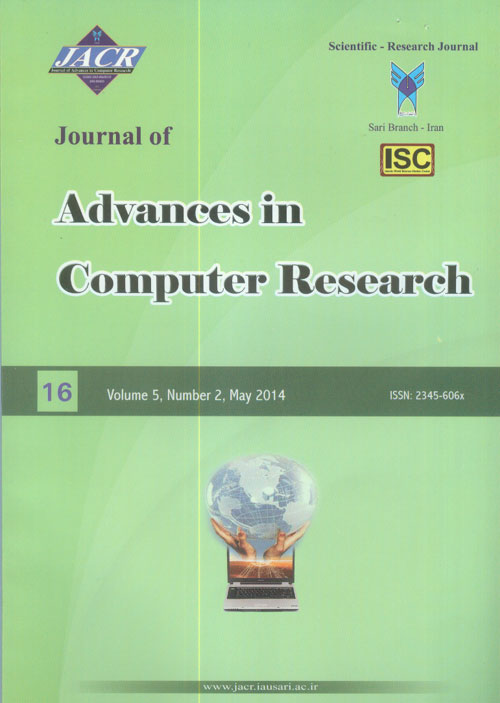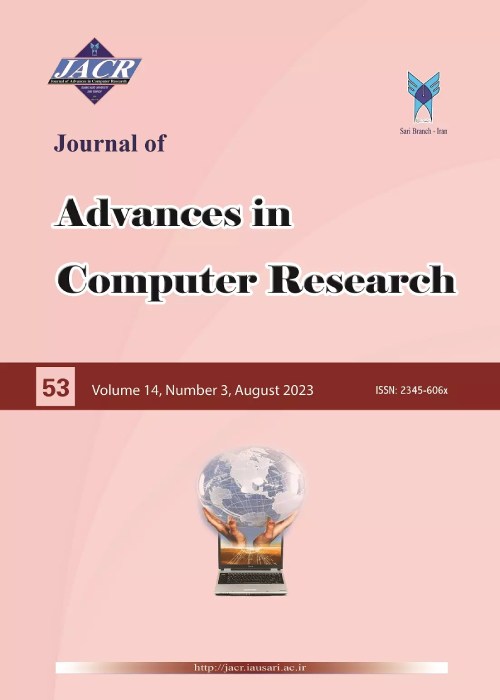فهرست مطالب

Journal of Advances in Computer Research
Volume:5 Issue: 2, Spring 2014
- تاریخ انتشار: 1393/03/15
- تعداد عناوین: 8
-
Pages 1-13Underwater Acoustic Wireless Sensor Network (UAWSN) use acoustic signals to transmit data. Acoustic signals in underwater environment have high bit error rate, long propagation delay and limited bandwidth. Another constraint in UWASN is energy. Due to these constraints, design of energy and bandwidth efficient and propagation delay aware MAC protocol is a great challenge in UWASN. Underwater sensor nodes have to share medium. The main role of the MAC layer protocol is to decide when a node accesses a shared medium and to resolve any conflicts between nodes. In this paper, we evaluate the performance of three famous underwater MAC protocols UWAN-MAC[1], R-MAC[2] and Slotted FAMA[3] in terms of packet drop rate, throughput and energy consumption. We have used Aquasim simulator to evaluate MAC protocols.Keywords: underwater MAC protocols, R, MAC, UWAN, MAC, Slotted FAMA, underwater acoustic wireless sensor networks, underwater simulation
-
Pages 15-36In this paper, an integration of Improve Particle Swarm Optimization (IPSO) in combination with Successive Quadratic programming (SQP) so called IPSO-SQP algorithm is proposed to solve time optimal bang-bang control problems. The procedure is found not sensitive to the initial guess of the solution. Due to random selection in the first stage of the search process, the chance of converging to the global optimum is significantly increased, without sticking in a local optimum. The combined technique gains both advantages of its original algorithms. The IPSO directly minimizes the cost function without the need for gradient-based techniques. The performance of the outcome will be increased when the SQP immediately undertakes the optimization task. This is shown via applying those on some other nonlinear systems. Consequently, the proposed algorithm is successfully applied on a time optimal bang-bang control of an autonomous underwater vehicle. A pitchprogramming task is also investigated for the autonomous underwater vehicle by designing an optimal PID controller.Keywords: Autonomous Underwater Vehicle, IPSO, SQP Algorithm, Optimal PID Controller, Pitch Programming, Time Optimal Bang, Bang Control
-
Pages 37-44This paper presents a novel salient pole synchronous generator i.e. permanentmagnet- assisted salient-pole synchronous generator (PMa-SGs). Due to saturation of conventional synchronous generators (SGs), permanent-magnet-assisted salientpole synchronous generators (PMa-SGs) are presented. PMa-SGs are a new type of salient-pole synchronous machines with extra permanent magnets (PMs) between the adjacent pole shoes. Placing PMs between adjacent pole shoes leads to a reduction in flux saturation plus an increase in armature flux linkage. In other words, the generator can operate at higher capacity. In this paper, a comparative study is carried out between conventional SGs and PMa-SGs based on finite element analysis (FEA). This is done via simulation of a PMa-SG compared to a conventional SG. Simulation Results show superiority of PMa-SGs over SGs. In fact, in PMa-SG maximum flux density in stator core is increased and pole bodies are not saturated. Besides, PMa-SG has higher flux linkage compared to conventional SG. Therefore, higher voltage could be produced in the generator. In other words, the output performance of the PMa-SG is considerably better than that of a conventional SG.Keywords: Synchronous Generator (SG), Magnetic Saturation, Permanent Magnet, assisted salient, pole synchronous generators (PMa, SGs), Finite Element Analysis (FEA)
-
Pages 45-50Since the pioneering work of Zadeh, fuzzy set theory has been applied to a myriad of areas. Song and Chissom introduced the concept of fuzzy time series and applied some methods to the enrolments of the University of Alabama. Thereafter we apply fuzzy techniques for system identification and apply statistical techniques to modelling system. An automatic methodology framework that combines fuzzy techniques and statistical techniques for nonparametric residual variance estimation is proposed. The methodology framework is creating regression model by using fuzzy techniques. Identification is performed through learning from examples method introduced by Wang and Mendel algorithm. Delta test residual noise estimation is used in order to select the best subset of inputs as well as the number of linguistic labels for the inputs. An experimental result for chaotic time series prediction are compared with statistical model and shows the advantages of the proposed methodology in terms of approximation accuracy, generalization capability and linguistic interpretability.Keywords: fuzzy techniques, statistical techniques, chaotic time series, prediction, regression
-
Pages 51-64Trajectories generally used to describe the space and time required to perform a desired motion task for a mobile robot or manipulator system. In this paper, we considered a cubic polynomial trajectory for the problem of moving a mobile robot from its initial position to a goal position in over a continuous set of time. Along the path, the robot requires to observe a certain acceleration profile. Then, we formulated an optimization approach to generate optimal trajectory profiles for the mobile robot in the cases of maximum-distance and minimum-time problems. The optimization problem presented to find the trajectory strategy that would give the robot time-distance optimality to move from a start point to an end point where the robot should stay inside its acceleration limits all the time. The problem solved analytically because as it is well known, numerical solutions and iterative methods are time-consuming, therefore, our closed-form solutions demand low computation time. Finally, the results are verified by simulations.Keywords: Mobile Robots, Trajectory Planning, Constrained Optimization, Acceleration limits
-
Pages 65-69DNA methylation is an important biological process involving in human disease such as cancer Insomia and Diabetes. Bisulfite sequencing (BS-Seq) with next-generation technology is an accurate method for measuring DNA methylation. BS-seq data analysis is a considerable way to recognize methylated cytosines and several tools have been developed to analysis BS-Seq such as BS-Seeker, B-SOLANA, BRAT, BSMAP and etc. In this paper, we propose a novel idea to get more efficiency in the sequencing process, This idea will improve the rate of accuracy in the BSOLANA alignment tool using a new method in the preprocessing step. Our method is based on modification in some regions of DNA strand named CpG islands. CpG islands are significant regions in DNA strand which frequency of methylated cytosines is less than other CpG contexts. We compared our method with previous methods in the preprocessing of the original BSOLANA tool using on HG19 reads. The comparison shows that new method provides more ability to align read sequences in the BSOLANA.Keywords: Bisulfite sequencing, DNA methylation, Alignment tools
-
Pages 71-80As technology scales deep into the nanometer regime, on-chip communication becomes more susceptible to transient noise sources, such as crosstalk, external radiation, and spurious voltage spikes. The Network on chip s modularity and reusability has brought about the use of error control methods to address transient errors in Network on chip links.In this work, we design a fault tolerance router with efficient area and power dissipated. Actually, we exploit the free virtual channel to store the redundant data. Virtual channel is used for deadlock avoidance it can be implement as 2, 4 or 8 channel. The almost time we can find a free channel that we can use in fault tolerance mechanism. We describe the proposed architecture with VHDL and implemented with synopsis compiler design. We use analytical model to evaluate the fault tolerance. The result shows that we improve the dynamic power dissipation, area, and reliability.Keywords: Network on chip, Buffering, Virtual channel, Fault tolerance router
-
Pages 81-96Today, optimal performance and cost advantages of using Internet telephony are obvious. Despite current standardized techniques, voice transferring through protocol (VoIP) has lower security than traditional telephony. One of the most important security issues which should be noticed in using VoIP is end -to-end user2 identity, i.e. when there is a connection between user A and B, user A should be assured of the identity of user B, and vice versa. The authentication of identity is one of so important information that could guarantee the security and integrity of information [1]. In this study, the security of VoIP and data steganography through the protocol has been investigated. Finally, a technique for data steganography4 over this protocol will be proposed using the method of Residue Number System3. Also, using the combination of RNS, DNA sequences, and Huffman compressing algorithm, an algorithm is proposed for data steganography through VoIP. The algorithm improves security of the process of transmission of hidden text and can use the bandwidth effectively.Keywords: Voice Over Internet Protocol, Steganography, Session Initiation Protocol (SIP), Residue Number System, DNA String, Huffman Algorithm


